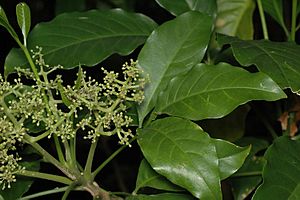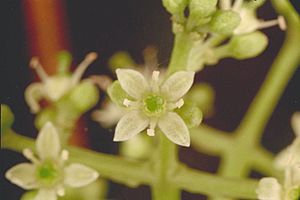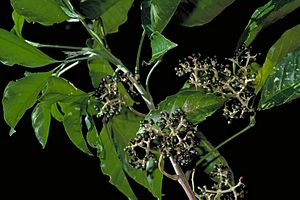Northern evodia facts for kids
Quick facts for kids Northern evodia |
|
|---|---|
 |
|
| Melicope vitiflora | |
| Scientific classification | |
| Genus: |
Melicope
|
| Species: |
vitiflora
|
| Synonyms | |
|
|
Melicope vitiflora, often called northern evodia, is a type of shrub or small tree. It also has other common names like fishpoison wood, leatherjacket, or leatherwood. This plant belongs to the Rutaceae family, which also includes citrus fruits.
It grows naturally in north-eastern Australia and New Guinea. The northern evodia is known for its leaves, which have three leaflets, and its green to white or cream-coloured flowers.
Contents
What it Looks Like
The northern evodia can grow as a shrub or a tree, reaching a height of about 14 to 40 metres (about 46 to 130 feet). It has bark that feels a bit like cork.
Leaves
Its leaves grow in pairs opposite each other on the stem. Each leaf is made up of three smaller leaflets, which is why it's called "trifoliate." The main leaf stalk, called a petiole, can be 20 to 160 millimetres (about 0.8 to 6.3 inches) long.
The individual leaflets are shaped like an egg or an ellipse. They are usually 90 to 200 millimetres (about 3.5 to 7.9 inches) long and 35 to 90 millimetres (about 1.4 to 3.5 inches) wide. Each leaflet has its own tiny stalk, called a petiolule, which is 2 to 30 millimetres (about 0.08 to 1.2 inches) long.
Flowers and Fruit
The flowers of the northern evodia grow in groups called panicles, which are found where the leaves meet the stem. These flower clusters can be 60 to 200 millimetres (about 2.4 to 7.9 inches) long.
Some plants have flowers with both male and female parts (these are called bisexual flowers). Other plants might have only male flowers or only female flowers. The plants can also be dioecious, meaning some plants have only male flowers and other plants have only female flowers.
The small green to white or cream-coloured petals are 1.5 to 3 millimetres (about 0.06 to 0.12 inches) long. The flowers have four stamens (the male parts) in the bisexual and male flowers.
Northern evodia usually flowers from October to January. After flowering, the plant produces fruit. The fruit is made up of up to four small pods, called follicles, which are 5 to 7 millimetres (about 0.2 to 0.3 inches) long and are joined at their base.
How it Got its Name
The scientific name of a plant helps scientists around the world know exactly which plant they are talking about.
The northern evodia was first described in 1871 by a botanist named Ferdinand von Mueller. He gave it the name Euodia vitiflora. He wrote about it in his book, Fragmenta phytographiae Australiae, after a sample was collected near Rockingham Bay.
Later, in 1990, another botanist named Thomas Gordon Hartley changed its name to Melicope vitiflora. This new name was published in a science journal called Telopea.
Where it Lives
Melicope vitiflora grows in rainforests, both along the coast and further inland. You can find it from sea level up to an altitude of 1,200 metres (about 3,900 feet).
It is found in New Guinea and in Australia, from the McIlwraith Range on Cape York Peninsula down to Broken Head in the far north-eastern part of New South Wales.
Conservation Status
In Queensland, Australia, this species is considered to be of "least concern" by the Queensland Government under the Nature Conservation Act 1992. This means that it is not currently at risk of becoming endangered.



